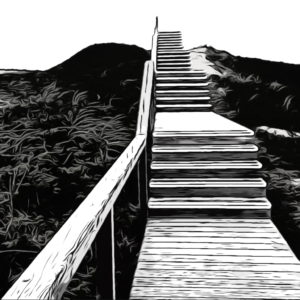NEULAND I (with excerpts from interviews with Ulrike Haage & Jon Balke) Simon Fisher Turner & Edmund De Waal: A Quiet Corner In Time / Cyrillus Kreek – Vox Clamantis & Jaan-Eik Tulve: The Suspended Harp of Babel / Jon Balke: Discourses / Sophie Tassignon: Mysteries Unfold (thanks to Ingo) / Ulrike Haage: Himmelsbaum / Sonar & David Torn: Tranceportation Vol. 2
„Ryuichi Sakamoto was one of the last pieces of the puzzle. I‘m trying ro remember how exactly I asked him if he‘d care to join us in spirit … it was through my friend in Kyoto, Shiro Takatani and his wife Yoko. A conversation maybe. I proposed we exchanged sounds of both our recordings of porcelain, and I found a way for him to beautifully put a full stop on the end of each side of the vinyl. Edmund also knows the master artist in Kyoto who Sakamoto recorded. It‘s a perfect circle. You couldn‘t have written a more perfect tale.“
(Simon Fisher Turner)
NEULAND II: Tony Allen & Hugh Masekela: Rejoice / Die Wilde Jagd: Haut (thanks to Hans Rollmann) / Neil Young: Homegrown / Benjamin Moussay: Promontoire / Lucinda Williams: Good Souls Better Angels / Bob Dylan: Rough And Rowdy Ways / Einstürzende Neubauten: Alles In Allem (2 tracks) / Roger Eno & Brian Eno: Mixing Colours
„Musically, Lucinda’s Good Souls is a world away from the expansive The Ghosts Of Highway 20, a sprawling, murky, late-career peak which recalls Neil Young’s underrated and equally defeated Sleeps With Angels. Where the atmospheric Ghosts sounded like it had been plucked from the ether, Souls sounds dug up from the dirt – twelve shitkicking jams which veer from righteous to resigned.“
(Alex Wisgard)
CLOSE-UP: „DIE ETWAS ANDERE KLAVIERSTUNDE / A SLIGHTLY DIFFERENT PIANO LESSON“ – Jon Balke (again) / Franz Schubert (Andras Schiff) / Max de Wardener (thanks to Uli) / Ian William Craig / a Keith Jarrett „nocturne“ moment for his 75th birthday / Harold Budd & Brian Eno / Anna Gourari / Ulrike Haage (again) / Peter Broderick plays Cage
„Full of utterly bare songs centred on the piano and voice, Red Sun Through Smoke cuts deep into the random nature of life. Love and loss grow entangled as the lifeline to a subject with nowhere to run or hide, nor to succumb to the comfort of stories to ease the burden and soothe the confusion. It’s a full acceptance of life’s random power, embracing human finitude and vulnerability, that gives the greatest strength and depth to one of Craig’s most mature works from a long trajectory of quiet artistic excellence. What on previous recordings was buried underneath thick layers upon layers of uncanny noise, now emerges unashamedly as a sentimental and metaphysically alone human being at the very intersection of the sublime and the material, the artist at his most humanly exposed. Craig’s advanced aesthetics of decay employ the volatility of tape decks and the fragility of analogue technology. The media’s vulnerability to loss becomes a metaphor for frail humanity, transcribing it into sound with palpable intimacy …“
(Danijela Bočev, The Quietus)
ZEITREISE 1: „DIE ENTLEGENEN UND POPULÄREN RÄUME VON SYLT IM LOCKDOWN / THE DESOLATE AND THE POPULAR SPACES OF SYLT IN LOCKDOWN“ – Yumiko Marioka, Bensarin Quartet, Kraftwerk, The Mamas & The Papas, „The dying sounds of Sylt“ (thanks to „The Source“), The Kinks, Hans Joachim Roedelius, „The Westerland dawn chorus“ (thanks to Rosato‘s remix), Dave Holland, „another green world“ in the background, Boards of Canada from „The Campfire Headphase“, a short apearance of the windharp from „Dis“, Leonard Cohen, Yo La Tengo (by mistake, the wrong track instead of the groove piece from Yo la Tengo, but I let it happen:)), and a Japanese piano „outro“ by Satoshi Ashikawa (thus, the Japanese framing of the hour was a nod towards the Lucillle Carra documentary „The Inland Sea“ I talked about and that has been beautifully reissued by Criterion – there will be a special remix of the Sylt hour that lets it all end after the last note of the Cohen song / poem. Good option.
„There is a memorable closing summary of Nick Drake’s music in Rob Young’s book, Electric Eden, one that can’t be read without a considerable swell of emotion. Young sees Drake’s work as something that engenders a beatific state: “if we all abandoned the calendar of industry, fashion and routine, slowed down to the magical time, stepped far beyond the chine of a city clock, took more time to hear what the trees whisper, what the sea sings and the moon brings, dusted by oak, ash and thorn, we might yet be granted a glimpse of Paradise.” Frankly you could say the same about Roedelius’s music on Tape Archive Essence.“ – btw: Rob Young will make a public talk with Irmin Schmidt at the next Punktfestival in early september (m.e.)
ZEITREISE 2: Fela Kuti and Africa 70: Afrodisiac / Lee Perry with Seskain Molenga and Kalo Kawongolo / Culture: Two Sevens Clash / Edikanfo: The Pace Setter
ZEITREISE 3: Eric Malmberg (thanks to Der Interaktionist)
(Journey’s end: E. Malmberg eschews familiar organ clichés (there’s not a single soul flourish in sight), opting instead for an almost classical-pop style that’s pretense-free, I might add. And, though the deep sonic richness of the organ spans centuries, there’s a modern dimension to the recording too; the ascending and descending whorls haunting the background of “Människan och evigheten” could be taken for a Kraftwerk nod. Häpna describes Den gåtfulla människan as “a highly personal record (and) a travel into the human psyche” and, while I’ve no doubt that that’s true, what’ll stay with you longest are the album’s timelessly simple yet melancholy melodies.”)
